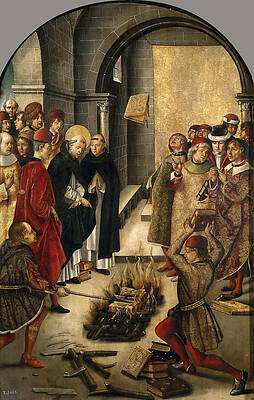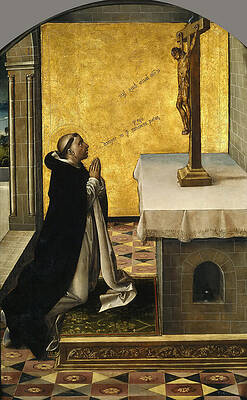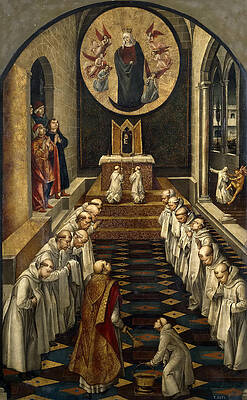Pedro Berruguete
Paintings
St. Dominic de Guzman
St. Dominic burns books of heretics
St. Peter
St. Peter Martyr in prayer
Appearance of the Virgin to the Dominicans
Portrait of Pope Sixtus IV della Rovere




The Shrine of St. Peter Martyr

The Miracle of St. Dominic with the cloud


Fine Art Prints | Greeting Cards | Phone Cases | Lifestyle | Face Masks | Men's , Women' Apparel | Home Decor | jigsaw puzzles | Notebooks | Tapestries | ...
Pedro Berruguete (c. 1450 – 1504) was a Spanish painter; his art is regarded as a transitional style between gothic and Renaissance. Berruguete painted famous paintings of the Inquisition. Born in Paredes de Nava, Spain, he went to Italy in 1480 and worked in Federico III da Montefeltro's court in Urbino, where he could see some works by Melozzo da Forlì. The Portrait of Federico da Montefeltro with His Son Guidobaldo (c. 1475), now at the Galleria nazionale delle Marche, has been attributed to him but the Flemish painter Justus van Gent working in Urbino at that time is another strong candidate for the authorship of this work. He returned to Spain in 1482 and painted in several cities, such as Sevilla, Toledo and Ávila. He was the father of an important sculptor, Alonso Berruguete, considered the most important sculptor in Renaissance Spain.
Work
First stage
Works from his first stage (between 1470 and 1471) include Verification of the cross of Christ in the Church of San Juan de Paredes de Nava and the Adoration of the Magi in the Alvarez Fisa collection.
Second stage (1471–1483)
In his second stage he travelled in Italy. There is little documentation of the work of Berruguete at this time, and there are controversies as to authorship. The remarkable Portrait of Federico da Montefeltro and his son Guidobaldo (Gallery of the Marches, Ducal Palace in Urbino), and the series of Famous Men of which it forms part (Louvre Museum, Paris and Galleria Nazionale, Urbino) are sometimes attributed to him although they are also attributed to the Flemish painter Justus van Gent.[1][2] It may also have been a collaboration between the two artists with Berruguete working on the series while working in van Ghent's workshop in Urbino.[1][3] This stay in Italy would have been interrupted by a return trip to Paredes de Nava in 1478 for marriage, after which he returned to Italy.
Third stage (1483-1503)
His masterpieces are the paintings of the kings of Judah, noting especially King David, which are situated on the high altar of the church of Santa Eulalia de Paredes de Nava (Palencia). Despite archaic elements (frontal composition, gold background), they are a gallery of portraits of intense realism.
Many of his best works can be seen in different localities of the province of Palencia: The Adoration of the Magi, The Annunciation of St. Mary in the parish of Santa Maria Museum of Becerril de fields; The Suitors of the Virgin and The Crucifixion in the Diocesan Museum of Palencia; The Lamentation over the body of Christ in the Cathedral of Palencia.
In the Church of the Assumption, Santa Maria del Campo (Burgos) are preserved two important works from this period: Beheading of the Baptist and the Baptism of Christ, which formed part of an altarpiece of the life of the Baptist, datable between 1483 and 1485, being among the first works of this third stage. Innovations in composition and perspective learned in Italy are evident in these two works. In Beheading, Berruguete used as background architecture inspired by the work of his contemporary Francesco Laurana in Urbino.
The Annunciation of the Cartuja de Miraflores is notable for the detail in objects and interesting set of perspectives, which creates a perfect illusion of space. In all these works the figures are highly individualized, and mastery of space, perspective and composition is enriched with an accurate sense of design and a wise use of color.
Berruguete's last assignment was the high altar of the Ávila Cathedral, which he was unable to finish due to his death. He painted for this work of late Gothic architecture several paintings of episodes from the life of Christ for the altarpiece, and figures of patriarchs for the predella. These paintings, perhaps reflecting the prevailing style in Castile at the time, use gold backgrounds and somewhat rigid compositions. The figures are of a more robust and monumental form than in previous works, perhaps in order to stand out in the distance of the main chapel. After the master's death the altarpiece was completed by Juan de Borgoña.
In 2003, to commemorate the fifth centenary of the painter's death, he was the subject of an exhibition in his hometown, Paredes de Nava, which brought together the best of his paintings and clarified some aspects of his life and work.
Reference
Paula Nuttall. "Justus of Ghent." Grove Art Online. Oxford Art Online. Oxford University Press. Web. 25 July 2014
Marcello Simonetta, Jonathan James Graham Alexander, Federico da Montefeltro and his library, Pierpont Morgan Library, Y.Press, 2007, p. 102
Stefano Zuffi, European Art of the Fifteenth Century, Getty Publications, 2005, p. 296
Sources
Brown, Jonothan (1991).The Golden Age of Painting in Spain. Yale University Press. ISBN 0-300-4760-6
Campbell, Gordon (2003) "Berruguete, Pedro (c. 1450-c. 1500)" The Oxford Dictionary of the Renaissance Oxford University Press, Oxford;
Chilvers, Ian and Osborne, Harold (eds.) (1988) "Berruguete, Pedro (d. 1504)" The Oxford Dictionary of Art Oxford University Press, Oxford;
Langmuir, Erika and Lynton, Norbert (2000) "Berruguete, Pedro (d. 1504)" The Yale Dictionary of Art and Artists Yale University Press, New Haven, CT;
Osborne, Harold (ed.) (1970) "Berruguete, Pedro (d. c. 1503)" The Oxford Companion to Art Oxford University Press, Clarendon Press, Oxford, England;
Myers, Bernard S. (ed.) (1969) "Berruguete, Pedro" McGraw-Hill Dictionary of Art McGraw-Hill, New York;
Parry, Melanie (ed.) (1997) "Berruguete, Pedro (1450-1504)" Chambers Biographical Dictionary Sixth edition, Larousse Kingfisher Chambers, New York
----
Fine Art Prints | Greeting Cards | Phone Cases | Lifestyle | Face Masks | Men's , Women' Apparel | Home Decor | jigsaw puzzles | Notebooks | Tapestries | ...
----
Artist
A - B - C - D - E - F - G - H - I - J - K - L - M -
N - O - P - Q - R - S - T - U - V - W - X - Y - Z
Retrieved from "http://en.wikipedia.org/"
All text is available under the terms of the GNU Free Documentation License








